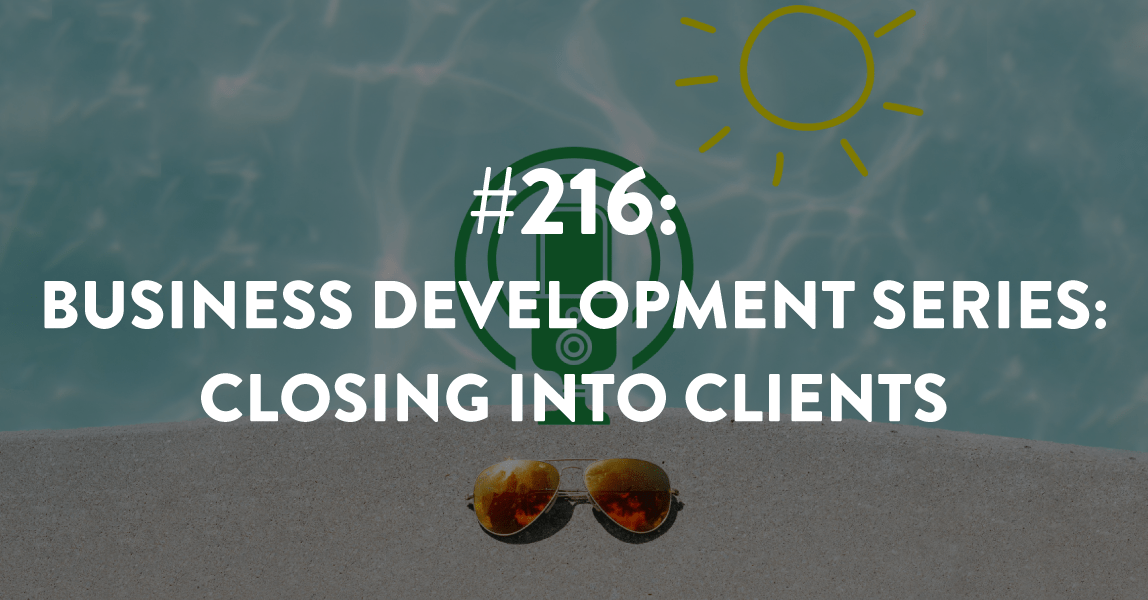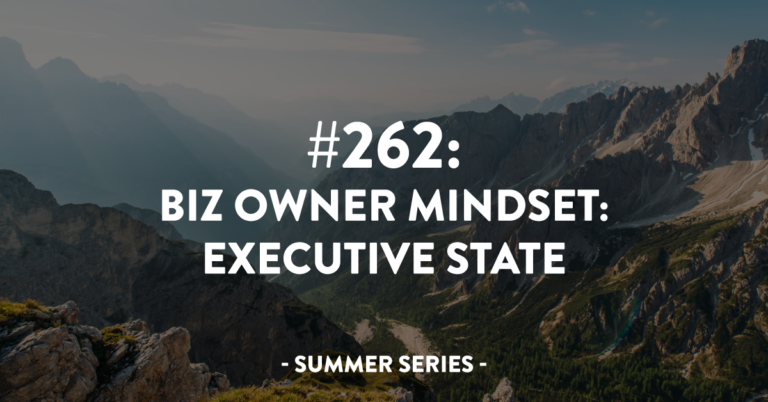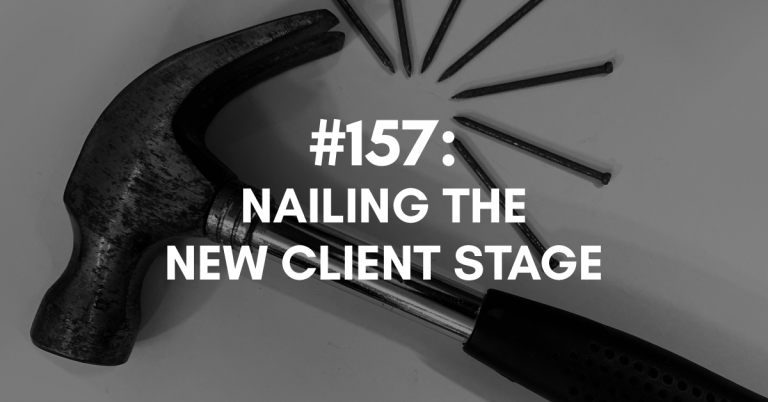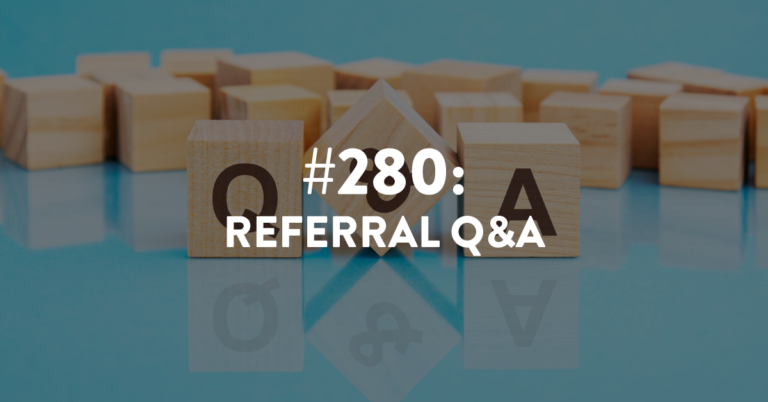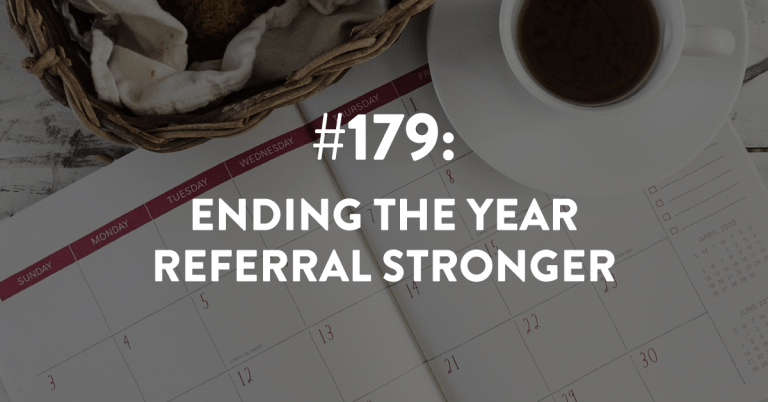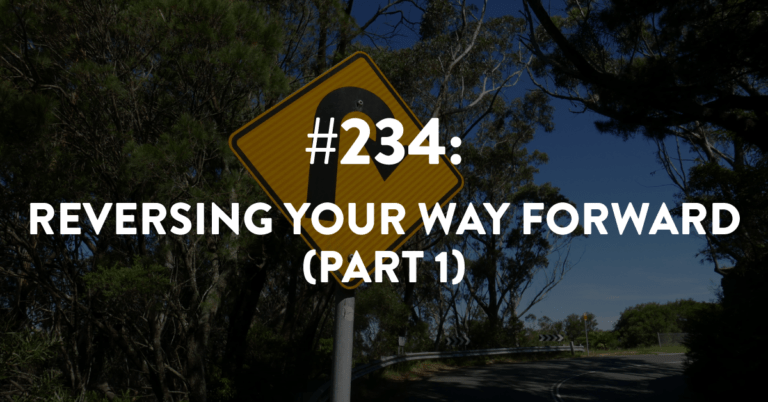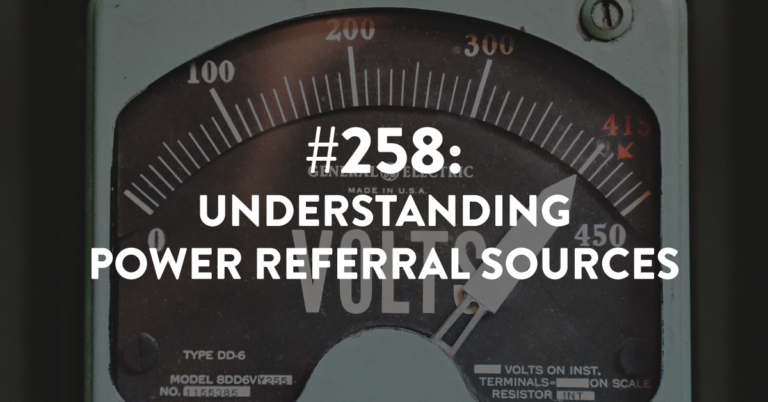Ep #216: Business Development Series: Closing into Clients
In earlier episodes in this series, we talked about awareness, defining sources, and the buyer’s journey. Now we are covering that important last step in business development: the close. When a customer says yay or nay to your proposal or offer, that is the close. This is part of the process that makes some people squirm or sweat, but fear not—I have some incredible tips and ideas for you that will make the closing go smoothly and successfully.
Come sit down, get out your notes, and let’s talk about closing from the perspective of someone who has been selling and closing for decades. I have a lot of sales experience that gave me tons of insight, and today I will be giving you what you need to build your closing skills.
You will get some actionable ideas and important advice on how to treat a prospect, as well as key areas where people tend to mess up the close so that you can recognize the warning signs and avoid those mistakes.
Links Mentioned During the Episode:
- Episode #214: BD Series: Figuring Out Your Sources
- Episode #215: BD Series: The Buyer’s Journey
- Episode #042: Asking for the Close
- The Dan Sullivan Question book
Looking for Referral & Client Experience Resources:
Take the Referral Ninja Quiz to test your skills and abilities at generating referrals. (FREE)
Buy my book – Generating Business Referrals Without Asking – and learn how to generate referrals through my 5 steps. (LESS THAN $16)
Consider joining Building a Referable Business™ – a unique way to learn all of my referral strategies and tactics with ongoing weekly access to me to answer your questions and help hold you accountable! Email me for more details.
Coming Up:
Next episode is #217, and we’re going to be talking about nurturing prospects.
Download The Full Episode Transcript
Read the Transcript Below:
Stacey Brown Randall: At the end of the buyer’s journey is another step called The Close. And I think it’s the one that actually makes people the most nervous. So, we’re going to talk about it.
You are not just another hustling salesperson. You are the expert, the
resource, the valuable partner for your clients, and how you grow your
business should reflect how your clients see you.Welcome to the Roadmap to Grow Your Business podcast. We generate
referrals without asking, build positive client experiences, and help
you take control of your business.
Here’s your charmingly sarcastic host, Stacey Brown Randall.
Stacey Brown Randall: Hey there, and welcome to episode 216 of the Roadmap To Grow Your Business Podcast. I’m your host, Stacey Brown Randall.
Well, we are about halfway through our Business Development Series, and I am excited for today’s topic. But one, not because I think this is actually a super fun topic, but one I think needs to be demystified so we can stop worrying about it.
Now, I know there are some of you listening and you’re like “The close? Taking a prospect to a client, closing them? I got that. That’s my happy place. That’s where I love to hang out.” That is awesome. You are a unicorn, my friend. That is not typically where most people hang out in terms of our business development, our sales process.
So, as we’ve been talking about in this series, we’re talking about our prospecting funnel. We’re talking about the funnel of how prospects come into our business and turn into clients.
And we talked in some earlier episodes about the awareness phase and defining your sources. Then we talked about in last week’s episode, about the buyer’s journey and what happens during the buyer’s journey. And now, we’re into that final step which is the closing step. It’s the close. It’s where someone says yay or nay to working with you.
And there are some of you listening that are like, “This is my jam. I love hanging out in the close step.” Like I said, you, my friend are a unicorn and that is awesome. Most of us are not though.
Most of us are at this place where we know what we do is going to be amazing if the people would just say yes to working with us. And I think the longer you’re in business, you just naturally get better at this stuff because you kind of have to, and you kind of do it more and more. So, you naturally get better.
I mean, I can clearly remember early conversations that I had almost a decade ago; a lot of times sitting in a Starbucks with somebody and going through the process of having them decide to work with me or not.
And then I like fast forward today — and I’m not sitting in a Starbucks actually when I talk to people about working with me. It’s either on the phone or over Zoom. But I don’t have the same concerns. I don’t have the same fears.
I still don’t always know if someone’s going to say yes or no to working with me, but I certainly don’t cower at the idea of having to have the closing conversation with somebody.
So, let me just talk to you about this whole idea of closing prospects into clients in kind of like a best friend way. This isn’t like, I am an expert at sales and I’m an expert at closing and you’ve got to do it this way. That’s not what I want this episode to be about. I actually don’t feel qualified to give it to you in those terms.
What I do feel qualified to do though, is talk to you about somebody who has been selling and closing for decades. And I don’t just mean this business, I mean my business prior, and I mean all of my sales and marketing experience prior to that, I have a lot of sales experience.
And not necessarily because I like woke up one day when I was a little girl and said, I want to be a salesperson when I grow up. My mom was in sales so I was definitely exposed to it. And then my father was an author and he was always selling his books, so I was exposed to that.
But I didn’t wake up saying I want to be the most amazing salesperson. And I’m guessing as the expert at what you do, the expert attorney, financial advisor, architect, interior designer, real estate agent, mortgage broker, consultant, coach, whatever it is — you didn’t wake up thinking I want to be the best salesperson either, and I want to be able to close with the best of them.
But this is still a strategy, this is still a skill, I guess, I should say, we have to be good at. So, I’m going to take what I have learned over my decades of doing the sales thing. I just used air quotes that you cannot see. One of these days maybe we’ll be a video podcast. And then you can see all my crazy hand motions, but until then …
But what I do want to talk to you about, it’s kind of like that best friend coming alongside you, your business buddy, coming alongside you and being like, “Hey, let’s make sure you’re comfortable with this concept of taking a prospect into becoming a paying client.”
So, I get that there are many considerations when people talk about closing and I understand for a lot of you, it brings up all the feels, like all the feelings. But the truth is it is a part of your business. If you do not have paying clients, you do not have a business, period.
So, this episode is not going to be treated as a how-to, or you must. It’s just more about a couple of tips, a couple of things that I remind myself of that have helped me when I get to this stage with the prospect. And this stage, of course being, they’re aware of me, they’ve gone through my buyer’s journey, and now, it’s time to decide, are you going to work with me? Yes, no, or not yet.
Because that truly is the three answers that can come out of a buyer’s journey; is “Yes, where do I sign up? Nope, this isn’t for me, or not yet, but I may be interested later because of X, Y, Z issue happening in my life now.”
So, I want you to listen to these thoughts that I have, and then just use what works for you. I mean, maybe what I’m about to talk to you about you know. Like you’re like, “Got it, done. Basically, I just checked the boxes as Stacey was talking.”
For others of you though, it just could be some really good reminders, maybe, as some things maybe you’ve forgotten. And for some of you, it may be very new. But I just want to give you some pointers that work for me and possibly maybe some food for thought, if you want to change some things up on how you’re doing things in this part of your sales process.
But I do want you to understand what I’m not going to talk about. I am not going to talk about convincing someone to buy from you because I don’t think people want to be convinced. And I mean that in terms of people want to buy, they don’t want to be sold to.
Have you ever been in a position where somebody is just like hammering you, hammering you, hammering you. And part of you is like, “Oh my gosh, if I just say yes, this person would go away?” But then of course, you don’t want to say yes because you don’t want whatever it is they’re hammering you about.
I’m not ever going to teach you to be like that. I mean, that’s not who I am, that’s not how I want you to treat me, if I am potentially talking about being a client of yours.
So, this isn’t about convincing you. This isn’t about like talking you into something that you may not make the decision to do if I wasn’t using these tactics to talk you into something.
This is not about selling per se and to trying to like sell someone, to get them to say yes to something. It’s about creating an opportunity for them to make the decision they want to buy. They want to say yes.
When somebody joins any of my programs, whether it’s my online programs and those are like hundreds or a couple of thousand dollars, or it’s working with me inside BRB, my group, coaching experience, Building a Referral Business, which is more than just a couple of thousand dollars to work with me on.
I want them to be excited at the decision. I’m okay if there’s a little nervousness, there’s a little apprehension, that happens when you’re spending money on anything. But ultimately, I want them to come in and I want them to be excited.
And the idea of how your clients are excited to start with you and excited to give you money. Whereas they may have a little apprehension, they’re also excited to get going. That all happens because of what happens during your sales process. And it starts when they become aware to you, and it moves when they’re in the buyer’s journey. And then it ends with how the closing happens as well.
Like I think about someone who recently joined my Building a Referral Business Program, and he had posted in our group, we have a community group for everybody’s in some of my programs.
And he posted there. It was like, “I signed up and I heard the hallelujah chorus start singing from the heavens that I had finally found something that was going to work for me.”
That’s what I want all my clients to feel. I mean, they may not actually say those words like he did, but I know that happens because of how I handle myself. And I handle the delicate balance between our relationship when somebody is making the decision to say yes to working with me.
When somebody is a prospect of mine, I recognize what they’re thinking, what they’re going through, what they’re trying to process through. And I’m respectful of that.
Now, that doesn’t mean I want to let people just live in limbo and never make a decision with me. But I also know that the people that I want rolling in the door are never going to roll in the door and feel forced to be there.
Because when they feel forced to be there, in my world, that’s going to look at somebody who’s not doing the work, doesn’t get the ROI. There’s never going to be a testimony or a case study or referrals. And they may even default on their payment plans if they went the payment plan route.
So, for me, I want to make sure that when people say yes to working with me, it’s done in an environment where they really do feel like it is their decision.
Now, it’s my job to help them get to that decision. It’s also my job to help them realize that this is not the decision for them to make as well as it is for others, it is the decision for them to make, and that I would be pleased as punch to work with them.
So, here’s just a couple of things I want you to keep in mind. Okay, again, this is not about trying to convince someone to work with you or to buy from you. This is not about the convincing piece. This is about, it’s an opportunity for them to make a decision on, and I want them to be all in when they make the decision.
So, here’s some things I want you to consider when it comes to taking a prospect through the process and getting them to the point where they were going to say yes or no.
Number one, you do have to be comfortable asking people if they’re ready to start. Sometimes when you’ve answered all the questions and they’re not like, “Okay, let’s do this,” you have to recognize the moment in those conversations where you can say, “Hey, are you ready to do this?”
It’s like an invitation to make a decision. I’m not telling you, you have to make a decision, but I am inviting you to make a decision because I’ve given you everything I could possibly give you. You’ve asked all your questions you could possibly ask. You’ve thought about it, you just need to decide; yes or no, or not now.
And so, it’s really important that you’re comfortable asking people if they’re ready to start. It’s like extending an invitation. And so, you have to recognize moments in your process where that is important, where it is important for you to be the one to say, “Hey, are you ready to get started? What would it look like for us to get started?” I think that’s really, really important.
Another thing I want you to kinda keep in mind is recognizing what’s called buying triggers. Recognizing buying triggers.
Now, I did an episode so long ago, it feels like. But I did an episode, it’s episode 42. I will link to it in the show notes. And the show notes page for this episode is staceybrownrandall.com/216 for episode 216.
But I did an episode, episode 42 with Nikki Rausch, who is with Sales Maven. And we talked about her buying triggers. Now, in the episode, we go through like the three buying triggers that I thought were the most interesting, but she has 17 of them.
And it’s recognizing when people are doing these things or saying these things, they’re actually considering saying yes; saying yes to buying, saying yes to hiring, and you need to be able to recognize those.
So, I’m going to link to that episode because you actually can download one page PDF that list out all 17 of her buying triggers. She has a book though that really explain things better and information on her book is also available on that show notes page for episode 42. But again, we’ll link to it on the show notes page for this episode.
But she goes through and kind of explains some of these buying triggers. And her book is an excellent, fast read just like my book as well. And what I love about that is it gives you things to have as like parameters. It’s like, hey, if they are asking about results and what to expect, they’re seriously considering buying.
They still may say no, but they’re at the point where they’re considering buying. That’s one of her buying triggers; asking why or how people work with you. That is another buying trigger. I know when people ask me, “So, who’s not successful with your program?” I’m like, okay, they are seriously considering being a part of my program.
And they really want to understand how to be successful by understanding who’s not successful. And I have a solid answer for that because I have seen it over and over and over again for a decade of what it looks like to be successful versus those who are not successful. If you’re wondering, I’ll give you a hint; it has to do with not doing the work. Just going to put it out there.
Now, some of these buying signals or buying triggers are really, really easy to understand. I think some of these buying signals are really easy. Like when they ask about pricing or they ask about payment options or payment plans. When they’re trying to get a sense of “I’m going to do this and what does it look like for me?”
But other ones, I think people, I think it’s really important that you understand when somebody is actually in the frame of reference and that mindset of being like, “Yeah, I think I want to do this.” And then there’s certain things they start saying that Nikki calls buying signals. And I just think you need to be aware of them.
So, that is the second tip that I would give. Recognizing what some of these buying signals are has allowed me to also create responses for them so that I’m not like … ah, ah, ah — when I hear it, I know exactly what it is and I have responses for it. And it just becomes a part of like the stuff that lives in my brain that I pull out when I need it. But anyways, they’re 17, they’re really good.
And then the other one I want to talk about is this whole idea of objections and how to overcome them. People use objections when they don’t want to make a decision. And sometimes, they use objections because they truly don’t need to be buying something.
Figuring out which it is between those two scenarios sometimes is not easy to do. And while it’s not easy to do, deciding between is this objection because this person doesn’t want to make a decision or they just need more information so they can make a decision, versus it being that they truly have an objection because they truly don’t need to say yes to you; figuring out the difference between them can be hard, but it is something that we have to understand and respect.
Now, I know there’s a ton of people out there that will teach you how to overcome objections. Like, “Oh, it’s too expensive” or, “Oh, I don’t have the time.” And I think generic objections like that need responses to them.
One of the things I know that when people are talking to me about my programs is that we all make assumptions. I do it. I do it when I’m thinking about other people’s programs. I’m like, “Oh, that sounds like a lot of work” without truly actually knowing, is it a lot of work? And is the work actually then worth the results I’m going to get? So, then who cares how much work it is if I’m going to get the results I want.
And so, I think it is important to recognize when there’s objections because people are like, “Oh, I don’t know if I want to make this decision, I don’t know if I can do this” and then helping them understand where they may be thinking about this incorrectly, versus them kind of making those excuses and giving you those objections.
Because at the end of the day, they just really need to like just step up and say no, but they just won’t. So, you’ve got these objections. I do think it’s important for you to understand what are the key objections that people have to saying yes to you, and then understanding how you respond to those.
But I hope your responses to those objections come from a place of understanding that you’re not in their shoes and you don’t know everything that they have going on in the back end. And it’s your obligation, I believe, to make them understand what they may be thinking incorrectly about what you do, and how you help people, but definitely not pushing them with slick explanations that moves you more into the convincing place than it is into the invitation or opportunity to work with you.
So, there are objections that I get and there’s some pretty standard ones. And the longer you do this, the more you start hearing the same objections over and over again.
I think if you don’t take notes of what the questions people ask you or what they say when you’re going through your sales process, it may take you longer to identify what these objections are that keep coming up. But if you’re making note of them, you’ll notice pretty quickly, “Wow, I always get this objection.”
I don’t want to call it a standard response, call it whatever you want; to be able to make sure they understand why they may be thinking about something incorrectly, that’s good business.
The ability to be like, “Oh, your objection is that you think this is going to take too much time, what do you mean by that? Like how much is a lot of time?” And then getting them to see like, “Well, I just feel like I’m going to have to be doing something with my referral sources like every single day.”
And then I can be like, “Oh great. Let me just run through again, what our referral plan looks like. And actually, how often you’re doing something because it’s not daily, weekly, or monthly.” And then they’re like, “Oh yes, I probably miss that.” And so, then it invites them into a conversation to overcome that objection.
So, I typically try to respect the objections that people have by asking a clarifying question; “Oh, I just can’t afford that.” “Okay. Well, why don’t you explain to me like how much when you receive a new client, what’s the revenue that new client usually brings? Like what’s the range?” I know we all sell different things at different price points, but like what’s the range.
And if they tell me, “Well, a referral’s worth $200 to me,” I’m like, “Okay, you’re going to need a lot of referrals to do the ROI with what I teach. I understand that.” But if someone’s like a new referral’s worth $30,000,” I’m like, “Okay, let’s put this in perspective of what my program will provide to you.”
And then using numbers of my clients because that’s real data that I can use, not made-up data, but like real data that I can use to show the ROI and how quickly somebody had the ROI within one of my programs.
So, I always find that when you get an objection, ask a clarifying question. So, you can see, are they just thinking of something wrong or are they really just trying to tell you no, and they don’t know how, and then that helps you kind of answer — ask the clarifying question, get their answer, and then you can respond accordingly.
And I always let people know like, hey, when people tell me no … and this is just my final point, and then I’ll wrap up on this whole closing concept. But my final point here is, is that when people tell me no, I always say, “Okay, that’s fine. I’m going to be ready when you are.”
And the number of people that have said no to me, and then circle back around three months, six months, nine months, 14 months later, and say, “I’m ready,” I know that they kept a good feeling about me because of how I handled them saying no, not now, or I don’t think this is right for me.
For me, being like, “Okay, great. And if the time is right, I’ll still be here” because I will be. So, I think when we go into sales and particularly this closing conversation with people and we go in with the mindset of abundance and not scarcity, it allows us to have a better conversation. And it’s one that I think we should take seriously because it definitely makes it an easier conversation for all involved.
Now, any resources that I mentioned for this episode, of course, I’m going to link to them on the show notes page. That’s staceybrownrandall.com/216, but I really hope you take some time and think through these three plus my bonus point, that I went through with this episode about thinking about your closing process and how you handle closing prospects into paying clients.
Before I let you go though, have you checked out our new training? As I outlined, The Referral Ninja Master Roadmap. I detail out the science behind generating referrals naturally. And I would love for you to check out that training.
It’s just 20 minutes and it’s going to break down the science behind how I teach to generate referrals naturally. And then it’ll also talk about some of the finer points you need to be thinking about when it comes to generating referrals in your business.
To watch the training, you just need to go to staceybrownrandall.com/referral-roadmap. Again, that’s staceybrownrandall.com/referral-roadmap. I probably should come up with a better redirect link. Okay. We’ll make a note of that.
But I do hope you’ll check out this new training just 20 minutes, breaking down the science behind how you generate referrals naturally.
Coming up next week is episode 217, and we’re going to be talking about nurturing prospects because sometimes when they get to the end of your funnel or the end of your pipeline, and they haven’t decided to actually work with you yet, then they move into being nurtured to get them to a place where they can say yes, and we’re going to tackle that next week in episode 217.
But until then, you know what to do my friend; take control and grow your business. Bye for now.
Thanks for listening to the Roadmap to Grow Your Business podcast. To
access all resources and links mentioned in today’s show, and to
connect with Stacey, head over to www.staceybrownrandall.com.

